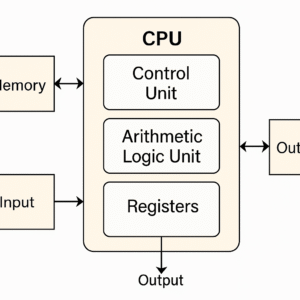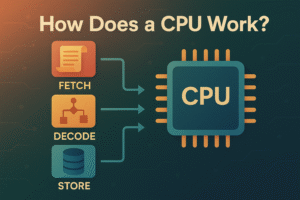How Does a CPU Work? – Simple Explanation
The CPU is often called the brain of the computer. It performs all the calculations and logical decisions required by programs. The CPU works in a cycle called the Fetch–Decode–Execute cycle.
🌀 CPU Working Steps:
Fetch – The CPU gets (fetches) instructions from the main memory (RAM).
Decode – The Control Unit (CU) decodes the instruction to understand what needs to be done.
Execute – The Arithmetic Logic Unit (ALU) carries out the task, whether it’s a calculation, data movement, or a logic comparison.
Store (optional) – The result may be stored back in memory or a register for later use.
This cycle repeats continuously while the computer is powered on.
🔧 Main Components of CPU:
Control Unit (CU):
Directs and controls all operations in the CPU.Arithmetic Logic Unit (ALU):
Performs all mathematical and logical operations.Registers:
Temporary storage units inside the CPU that hold data and instructions currently in use.Cache Memory:
A small, high-speed memory that stores frequently accessed data and instructions for quick retrieval.Buses (Data, Address, Control):
Pathways that carry data, addresses, and control signals between the CPU and other components.
📊 CPU Block Diagram (Generated Image Below)
Now, here’s a block diagram of a CPU showing all the key components and their connections:

CPU Working in Hindi – सीपीयू काम कैसे करता है?
CPU का पूरा नाम (सेंट्रल प्रोसेस यूनिट) होता है। इसे हम कंप्यूटर का दिमाग भी कहते है जो कंप्यूटर के कार्यो को पूरा करता है। इसे प्रोसेसर या माइक्रोप्रोसेसर के नाम से भी जाना जाता है।
CPU कंप्यूटर की मेमोरी से डेटा और निर्देश (instruction) को प्राप्त करता है और उन्हें execute करता है। यह निर्देश या डेटा को execute करने के बाद उन्हें वापस मेमोरी में स्टोर करता है।
CPU के कार्य करने की प्रक्रिया को नीचे step के माध्यम से समझाया गया है:-
1- Fetch (फेच)
कंप्यूटर की मेमोरी में कई प्रकार के प्रोग्राम या निर्देश स्टोर होते है। इस स्टेप में CPU प्रोग्राम या निर्देश को पढ़ता है और इन्हें प्रोसेस करता है। CPU में एक प्रोग्राम काउंटर होता है जो instruction के address को स्टोर करके रखता है।
2- Decode (डिकोड)
सभी निर्देशों को पढ़ने के बाद CPU, मेमोरी से प्राप्त सभी instructions को डिकोड (decode) करता है।
3- Execute (एक्जिक्यूट)
यह CPU की कार्यविधि का तीसरा स्टेप है, इसमें CPU सभी निर्देशों (instructions) को execute करता है और सभी कार्य को पूरा करता है।
4- Store (स्टोर)
निर्देशों को execute करने के बाद जो डेटा प्राप्त होता है उसे CPU कंप्यूटर की मेमोरी में स्टोर कर देता है।
Features of CPU in Hindi – सीपीयू की विशेषताएं
1- CPU को कंप्यूटर का दिमाग भी कहते है जो कंप्यूटर के सभी कार्यो को execute और नियंत्रित (control) करता है।
2- सीपीयू के अंदर एक प्रकार की cache मेमोरी होती है जो मेमोरी को तेज गति (speed) से एक्सेस करने में मदद करती है।
3- वर्तमान समय के सीपीयू multi-core के साथ आते है जो कंप्यूटर सिस्टम की कार्य करने की क्षमता को बढ़ाते है।
4- इसके कार्य करने की गति (speed) को GHz (Gigahertz) या MHz (Megahertz) में मापा जाता है।
5- CPU एक प्रोसेसर है जो इनपुट/आउटपुट डिवाइस और मेमोरी के साथ संचार (communication) करता है
